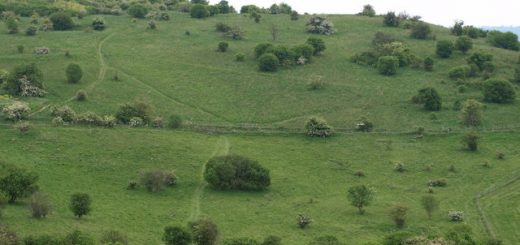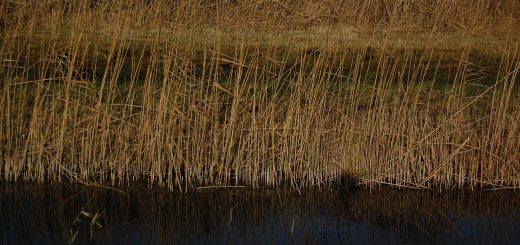Church of Saint Mary the Virgin, Frensham
Inside the 13th century Church of Saint Mary the Virgin at Frensham is held a beaten copper cauldron. The medieval 19 inch deep cauldron is believed to have been used for the brewing of Church Ale and has apparently been kept in the church ‘from beyond the memory of man’. There are several stories concerning the origins of the cauldron and how it came to have spent the last several centuries in Frensham Church.
![BabelStone [CC BY-SA 3.0 (https://creativecommons.org/licenses/by-sa/3.0) or GFDL (http://www.gnu.org/copyleft/fdl.html)], from Wikimedia Commons](http://www.mysteriousbritain.co.uk/wp/wp-content/uploads/2015/07/Mother_Ludlams_Cauldron_1-300x295.jpg) One folk tale says the cauldron belonged to Mother Ludlam, the White Witch of Waverley who lived in a small cave near Farnham. One day the devil wearing a disguise tried to borrow the cauldron from Mother Ludlam, who, recognising her visitor true identity, refused the request. The Devil then stole the cauldron and fled the scene of the crime with Mother Ludlam in pursuit. The Devil dropped the cauldron on Kettlebury Hill after creating the hills known as the Devil’s Jumps around Churt with his huge leaps. In order to protect her cauldron from the Devil, Mother Ludlam placed it in Frensham Parish Church after she had recovered it from Kettlebury Hill.
One folk tale says the cauldron belonged to Mother Ludlam, the White Witch of Waverley who lived in a small cave near Farnham. One day the devil wearing a disguise tried to borrow the cauldron from Mother Ludlam, who, recognising her visitor true identity, refused the request. The Devil then stole the cauldron and fled the scene of the crime with Mother Ludlam in pursuit. The Devil dropped the cauldron on Kettlebury Hill after creating the hills known as the Devil’s Jumps around Churt with his huge leaps. In order to protect her cauldron from the Devil, Mother Ludlam placed it in Frensham Parish Church after she had recovered it from Kettlebury Hill.
Alternatively the cauldron was left in the church by someone who had borrowed it from Mother Ludham. In order to avoid her anger for not returning it on time, he fled into the church for sanctuary and the cauldron has remained there since.
Other origin stories refer to the cauldron as belonging to the fairies who, like Mother Ludham, would loan it out. One such story has a man borrowing the cauldron from the fairies on Stony Jump (one of the hills known as the Devils Jumps), but when he did not return it they cursed him. The cauldron was tasked to follow him everywhere he went and eventually he fled to Frensham Church where he died and so the cauldron remained.
The following version of the tale dates from the 19th century, though I am uncertain whether it is older that those above or not.
According to ‘English Fairy and Other Folk Tales’ (1890) by Edwin Sidney Hartland, ‘IN the vestry of Frensham Church, in Surrey, on the north side of the chancel, is an extraordinary great kettle or caldron, which the inhabitants say, by tradition, was brought hither by the fairies, time out of mind, from Borough-hill about a mile hence. To this place, if any one went to borrow a yoke of oxen, money, etc., he might have it for a year or longer, so be kept his word to return it. There is a cave where some have fancied to hear music. In this Borough-hill is a great stone lying along of the length of about six feet. They went to this stone and knocked at it, and declared what they would borrow, and when they would repay, and a voice would answer when they should come, and that they should find what they desired to borrow at that stone. This caldron, with the trivet, was borrowed here after the manner aforesaid, and not returned according to promise; and though the caldron was afterwards carried to the stone, it could not be received, and ever since that time no borrowing there.’























Re: Church of Saint Mary the Virgin, Frensham
Topographical History of Surrey, by E.W. Brayley assisted by J. Britton and E.W. Brayley (1841)
The Rev Thomas Mantell DD who died in December 1804 purchased of Wm Bishop esq about the year 1790 the lease of the great tithes of Frensham, Elstead and Bentley, but by exacting them in kind he became involved in disputes and law suits with the land owners. This in the end proved ruinous both to himself and his family. He married Lady Banks a widow whose children by a former husband were left without provision and his son was sent to school to the parish clerk at Elstead. In the Vestry here says Aubrey is an extraordinary great Kettle or Cauldron which the inhabitants say by Tradition was brought hither by the Fairies time out of mind from Borough Hill about a mile from hence. To this place if any one went to borrow a Yoke of Oxen Money etc he might have it for a year or longer so he kept his Word to return it. There is a Cave where some have fancied to hear Musick. On this Borough Hill in the Tything of Cherte is a great Stone lying along of the length of about six feet they went to this stone and knocked at it and declared what they would borrow and when they would repay and a Voice would answer when they should come and that they should find what they desired to borrow at that Stone. This Cauldron with the Trivet was borrowed here after the manner aforesaid but not returned according to Promise and though the Cauldron was afterwards carried to the Stone it could not be received and ever since that time no Borrowing there. But I do believe that this great Kettle was an ancient Utensil belonging to their Church House for the use of A ymroi or Love Feasts or Revels Aubrey Surrey vol iv pp 366 367 Salmon after remarking that the great Cauldron which lay in the Vestry beyond the memory of Man was no more brought thither from Waverley than as the report goes by the Fairies says It need not raise any man’s wonder for what Use it was there having been many very lately to be seen as well as very large Spits which were given for entertainment of the Parish at the Wedding of poor Maids Surrey p 139 Grose has connected this Cauldron with his account of the White Witch called Mother Ludlam of whose Cave or Hole in the sand rocks under Moor park he has given a view According to his version of the tradition the venerable old lady when properly invoked assisted the poor neighbours by lending culinary utensils Sc the business being thus transacted The petitioners went to the cave at midnight turned three times round and thrice repeated aloud Pray mother Ludlam lend me such a thing naming the utensil and I will return it within two days On the next evening the requested moveable was found at the entrance of the cave This intercourse long continued until once a person not returning a large Cauldron according to the stipulated time Madam Ludlam was so irritated that she refused to take it back when afterwards left at the cavern and has never since accommodated any one with the most trifling loan cauldron at Frensham The story adds that the Cauldron was carried to Waverley Abbey and after the dissolution of that monastery deposited in Frensham Church Grose Antiquities or England &c vol vp 1 12 This Cauldron is of Copper Its diameter in the upper part is two feet eleven inches its depth is one foot seven inches An iron band strongly rivetted surrounds the middle swell and is connected on each side with a flat ring handle four inches and a half in diameter It stands upon an iron trivet with three expanding legs